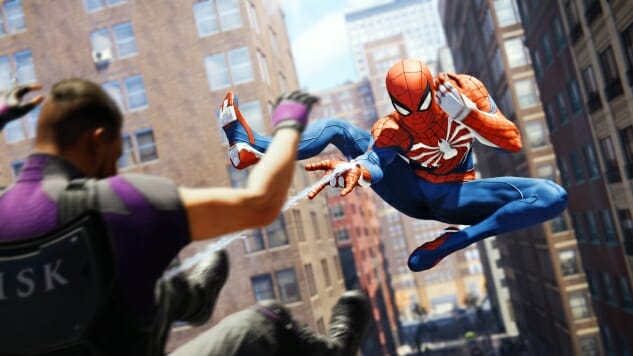Spider-Man Combines 50 Years of History with Great Combat and Webslinging

You can’t keep a story going for 55 years without repeating yourself or trying to start fresh from time to time. Spider-Man’s seen more than his fair share of turmoil over the decades, growing from a high school wallflower into a teen superhero, to an overtaxed college student, to a man in his mid-20s with a career and a supermodel wife, to a man in his mid-20s with a quarterlife crisis who somehow made his marriage disappear through a deal with Marvel’s version of the devil and then started acting like a college student again. The Peter Parker in the comics was allowed to grow and change in many small ways (and a few major ones) since he was first introduced in 1962, and for longtime comic readers that’s a notable part of the character’s appeal.
Spider-Man, the new adventure from the designers behind Sunset Overdrive and the Ratchet & Clank games, doesn’t star a Peter Parker from any specific era of the comic books. This Parker is an experienced superhero somewhere in his early to mid 20s, putting his college degree to use as a lab assistant for a genius scientist while trying to get back together with his ex, Daily Bugle reporter Mary Jane Watson. This is an adult Spider-Man with adult problems, closer to the character from Dan Slott’s decade-long run on Amazing Spider-Man than we’ve seen in other media before. It immediately sets this Spider-Man apart from the high schooler in the Marvel movies, which is a smart choice—it makes it harder to compare this to the extremely popular MCU version of the character, preempting any negative conclusions players might have made about the game. It’s more closely in line with the comic version of the character, but with a story that freely combines and twists characters, settings and plotlines from various different versions of Spider-Man we’ve seen over the decades. It pulls from the traditional Marvel comics and from Ultimate Spider-Man, and even hints at both the Sam Raimi and Marc Webb movies, synthesizing it all into a catholic take on the superhero. That makes it stand out amid the glut of Spider-product—this is its own unique, original, but very familiar take on the Spider mythos, and it should satisfy (and possibly even excite) any fan of the comics.
The graceful webslinging and acrobatic action should only increase that excitement. Swinging through this minutely detailed recreation of Manhattan remains as exhilarating at the end of the game as it does at the beginning. Add this to the class of videogames where simply moving around is a constant joy. And the combat, which incorporates Spider-Man’s webs into its terpsichorean rhythms, turns into a flurry of fists and feet flailing about from one enemy to the next. You’ll unlock a number of different moves throughout the game, enough to keep combat largely interesting throughout, but not so many that you’ll forget about some of them in the heat of the moment. These fights capture the style and motion of fight scenes drawn by classic Spider-Man artists from Steve Ditko to Todd McFarlane, prioritizing speed and kineticism over the more sluggish brutality of less freewheeling brawling games.
If there’s a negative to this combat, it’s that there’s simply too much of it, especially over the game’s final acts. The story keeps adding new groups of enemies that will appear throughout the city—sometimes in fixed (if optional) scenarios, other times in seemingly random encounters—and once they’re all wild on the streets it can be difficult to go more than a few blocks without having to stop for a fight. And base battles, where you have to take out buildings full of men who work for crime bosses like the Kingpin or Mister Negative, can grow tiresome well before their six waves of enemies can be defeated. The amount of brawling can sometimes feel like padding, which is unnecessary in such an otherwise strong game.
